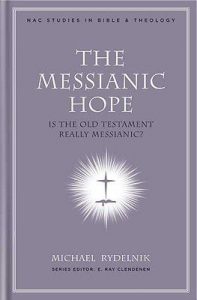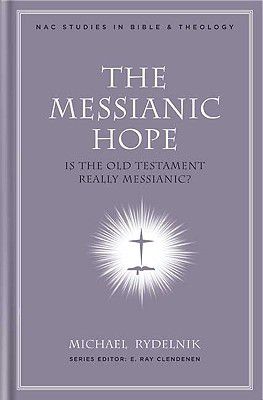Rydelnik, Michael. The Messianic Hope: Is the Old Testament Really Messianic? Nashville, TN: B & H Academic, 2010, pp. 206, $19.99, hardcover.
Born in a traditional Jewish home, Michael Rydelnik became a believer in Jesus after listening to the witness of his mother. Her faith in Christ led Rydelnik’s father to divorce her and as a consequence Rydelnik decided to study “the messianic prophecies of the Hebrew Bible” in order to prove his mother “wrong in attributing their fulfillment to Jesus of Nazareth” (p. 12). As time went on, Rydelnik also put his “trust in Jesus as Messiah and Lord” and became convinced that it is “essential to understand the Hebrew Bible as messianic.” (p. 12). As such, Rydelnik’s life experiences makes The Messianic Hope all the more compelling for evangelical circles. Given the modern consensus to “reject the idea that the Hebrew Bible has specific predictions of the Messiah” (p. 1), Rydelnik’s purpose in writing The Messianic Hope is to call evangelical scholars to “rethink this trend” since direct messianic prophecy “is the foundational element for identifying Jesus as the true Messiah” (p. 190).
Rydelnik begins his first chapter with tracing the trend away from viewing the Hebrew Bible as messianic. Rydelnik quotes the shocking words of various scholars—Tremper Longman III, Klyne Snodgrass, Larry W. Hurtado, and Daniel I. Block—who “recognize that there is something messianic about the Hebrew Bible” but not that it contains “predictions that Jesus of Nazareth fulfilled” (pp. 3–5). Instead, Rydelnik argues that they have “abandoned messianic predictions for the sake of respectability in the academy or acceptance among critical scholarship” (p. 190).
From here, Rydelnik explains three important reasons for acknowledging messianic prophecy within the Old Testament. First, the Scriptures themselves affirm their messianic nature. Second, the messianic Hebrew prophecies provide a biblical apologetic for identifying Jesus as the Messiah. Third, the Bible’s messianic nature “enables followers of Jesus to have confidence in the Bible as God’s inspired Word” (p. 8). The rest of the book simply seeks to provide evidence for these reasons.
Chapter two describes the different approaches to messianic prophecy that have developed since the work of Anthony Collins (Discourse of Grounds, 1724). Collins argues that all Old Testament prophecies were fulfilled during each prophets’ own lifetimes. A second view is known as sensus plenior or dual fulfillment. Three variations of this view are that of typical, progressive, and relecture fulfillment—all of which view the historical personages who fulfilled the prophetic prophecies as pointing towards the Messiah. Next, there are some who argue that the New Testament authors utilized midrash or pesher—a creative exegetical technique of early Judaism that modern interpreters should not utilize (pp. 21–22). Lastly, Rydelnik explains that a compositional approach to the Hebrew Bible provides evangelicals with a sound methodology for affirming Jesus’s direct fulfillment of these prophecies.
The next five chapters explain how one should analyze the messianic texts of the Bible from in light of a compositional analysis. Chapter three—relying mostly on the work of John Sailhamer (Introduction to Old Testament Theology, 1995)—affirms that the version of the Hebrew Bible found in the Masoretic tradition does not reflect the “original” manuscript in various places. Thus, Rydelnik demonstrates how certain texts (such as 2 Samuel 23:1 and Psalm 72:3) in the Masoretic tradition have diluted a messianic reading still preserved in other versions. This section would be even more helpful if it included an analysis of the different versions of Jeremiah, where the Masoretic tradition is obviously less messianic than the Septuagint. Chapter four highlights the numerous occasions of inner-biblical exegesis that read early biblical texts as messianic (see, for example, the reading of Genesis 49:10 in Ezekiel 21:27). Chapter five summarizes the canonical approach of Sailhamer and explains its usefulness in interpreting messianic prophecies. Chapters six and seven demonstrate that the New Testament writers did not create the messianic reading of the Old Testament but continued the tradition already found within it.
In light of Rydelnik’s exegetical analysis, he returns to a fuller demonstration of the presuppositions behind modern scholars who affirm that any valid exegesis of messianic prophecies should affirm a historical fulfillment before the time of Jesus. Rydelnik argues that the work of Rabbi Shlomo Yitzhaki (1040–1105), commonly known as Rashi, has been very influential to numerous scholars in the area of Old Testament exegesis. Rashi changed exegesis from being concerned with the literary aspects of the text to a concern for the historical circumstances surrounding the text. In Rydelnik’s words, “Rashi no longer understood the peshat [meaning exegesis or simple meaning] as the plain sense of the text but the historical sense” (italic original, p. 116). In a very persuasive manner, Rydelnik provides the reader with evidence of how the reading of certain texts changed after the time of Rashi (see pp. 123–128).
The book ends with three chapters that each provide a three-part analysis of three messianic texts—Gen 3:14–15, Isa 7:13–25, and Ps 110. Each of these texts is taken from one of the three sections of the Old Testament—the Torah, the Prophets, and the Writings. In each analysis, Rydelnik’s exegesis looks at the text from its immediate context (called intextual exegesis), its broader context (called innertextual exegesis), and its canonical context (called intertextual exegesis). While one may not agree with all of Rydelnik’s observations, his analysis does lead one to affirm that each of these texts is intentionally messianic and were read that way by authors in both the Old and New Testaments. A welcomed addition to this section would be an analysis of Exod 12:46 since it appears to be the referent for Jesus’s words in John 19:36.
In all, The Messianic Hope is a wonderfully crafted argument for the importance of affirming Jesus’s direct fulfillment of the messianic prophecies found within the Hebrew Bible. Though the work suffers from a few moments of repetitiveness, these are easily overlooked in light of the work’s entirety. Still, there are places where Rydelnik has oversimplified the views of some scholars. For example, though Block does not view Deut 18:15 as messianic, as Rydelnik states (p. 5), Block does affirm that Isa 52:13–53:12 is directly messiah (see For the Glory, 2014). Thus, Block does not view the Hebrew Bible as broadly messianic, as Rydelnik states (p. 3), but as directly messianic given his view of the progression of biblical revelation. Rydelnik’s response would probably be that Isaiah is “expanding and clarifying the message of the Torah” (p. 72), but The Messianic Hope is far too concise to deal with the issues of interpretation that divide Rydelnik and Block. Thus, Rydelnik’s work may not be very useful beyond its basic argument for the traditional view of messianic prophecies.
In conclusion, while many evangelical church members and pastors may already be convinced of the messianic nature of the Hebrew Bible, that evangelical scholarship has deemed such convictions as unnecessary implies that it will only be a matter of time before this is no longer the case. As Rydelnik states in his analysis of Isaiah 7:13–25, “their approach says that faith in Jesus is still the truth even if the virgin birth is questioned or if Isaiah’s prediction of it is explained away as exegetically untenable. But truth is foundational to faith” (p. 162). In other words, Rydelnik argues that numerous fundamental facts of the faith, such as the virgin birth, will become invalid if the messianic texts of the Hebrew Bible do not directly speak of Jesus—as affirmed by the New Testament authors. Though this suggestion might be dismissed as a logical fallacy—a slippery slope—Rydelnik demonstrates these repercussions in the work of Rob Bell (Velvet Jesus, 2005). If Bell is considered to be an extremist, then it is questionable as to why many evangelical scholars appear to affirm many of Bell’s hermeneutical premises (see pp. 146–147, 162). Instead, as Rydelnik argues, evangelical should join the “growing movement among some biblical scholars” who approach the text of scripture in light of its “final canonical form,” which will allow one to see the “Old Testament as an eschatological, messianic text” (xv).
Ron Lindo Jr.
New Orleans Baptist Theological Seminary





